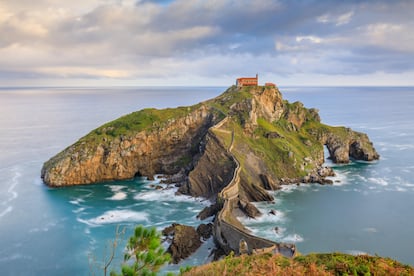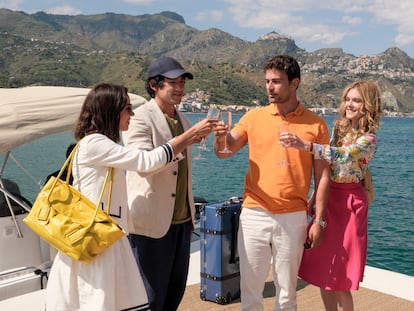When movie and TV locations become hot travel destinations
People once looked to paintings and books for vacation ideas, but now tourism offices are capitalizing on the popularity of major film and television productions

Two common conversation starters are “Where are you going on vacation?” and “What are you watching on television?” No one ever asked Vincent van Gogh about television, but Japan would have been his answer to the first question. The Dutch artist and other Impressionist painters of the time loved the Japanese woodblock prints called ukiyo-e because of their use of light, the landscapes they depicted and the technique for making them. Utagawa Hiroshige’s Sudden Shower over Shin-Ōhashi bridge and Atake inspired Western sensibilities and sparked an interest in travel to Japan. Movies and television are now doing what paintings and books used to do.
Before screens took over our lives, authors like Benito Pérez Galdós, James Joyce, Frank Kafka and Fernando Pessoa eloquently led readers through the streets of Madrid, Dublin, Prague and Lisbon. Now these virtual journeys are inspired by productions from HBO, Movistar Plus+, Netflix and other streaming platforms.

Movies and TV series show viewers familiar places and others they’ve only vaguely heard about. Places like Baltimore (Maryland, USA) from The Wire, New Orleans (Louisiana, USA) from Treme, Edinburgh (Scotland) from Trainspotting, Bath (England) from Bridgerton, Birmingham (England) from Peaky Blinders, the remote island of El Hierro (Canary Islands, Spain) in the series of the same name, and the marshes of Doñana National Park (Spain) in Marshland. Not to mention all the settings in Japanese anime, Turkish and Colombian soap operas, South Korean films and Nordic thrillers that turn passive viewers into potential tourists who are curious to experience the places they’ve seen on the screen.
The movie and TV locations are often highlighted to attract tourists to a country or city, and some become destinations in their own right. When a viewer from another country sees a production that takes place in Spain like Money Heist (La casa de papel), the experience can spark an interest in Spanish culture and a desire to visit the country. “These productions put cities, towns and places on the tourist map, and extends tourism beyond traditional sun and surf destinations,” says Francisco José Pradana, a professor of social sciences and communications at the European University of Madrid.

Screen tourism
Blockbuster movies can become promotional campaigns for the locations where they are filmed. It’s called screen or film tourism, and predates the rise of all the streaming video platforms. Movies that make you want to travel have been around for a long time. Consider the James Bond films in which Agent 007 takes sybaritic trips around the world, or the Crocodile Dundee movies that caused requests for tourist visas to Australia to skyrocket by 40% from 1984 to 1992, according to Cultural Affinity and Screen Tourism, a study conducted by the World Tourism Organization and Netflix. Thailand’s enchanting beaches have always attracted tourists, especially low-budget backpackers. But when The Beach came out, so many people flocked to Maya Bay on the island of Phi Phi Leh – about 5,000 every day – that it had to be closed for a while to restore its white-sand beach and coral reefs.
Film tourism began to take off after The Lord of the Rings trilogy, which increased the number of annual visitors to New Zealand by 40% from 2000 to 2006. The Harry Potter saga boosted the number of visitors to the UK filming locations by 230% from 2011 to 2013. The city of Birmingham in central England is the setting for the Peaky Blinders series. The popularity of the period crime drama led to a record number of domestic and international visitors to the city in 2018 – 42.8 million tourists – many of whom also visited the Black Country Living Museum in nearby Dudley, the main filming location for the series. From 2011 to 2019, all eight seasons of Game of Thrones were filmed in Northern Ireland, Croatia, Malta, Iceland and Spain. Every one of these locations has seen a significant increase in tourists, even after the series ended in 2019.
To attract film and TV productions, a location must have striking settings, locally available industry professionals and tax incentives. The Spain Film Commission and its 39 members throughout the country has worked diligently to put all these prerequisites in place, so it’s no mystery why Spain has become a preferred location for Netflix productions.
Tourism agencies leverage popular productions to promote their filming locations. “When a series or movie like Game of Thrones is filmed in Ireland, we try to make a connection with the destination,” said Soraya Gabriel, a public relations executive with the Irish Tourism Office in Spain. Themed city and online tours are developed, social media campaigns are created, and interviews are recorded with actors, directors and screenwriters talking about their experiences in the destination. Ireland’s Game of Thrones promotional strategy culminated in February 2022 with the opening of the Game of Thrones Studio Tour in the town of Banbridge.

Cities become characters
While financial and logistical factors may drive the selection of a particular filming location, the location itself may be as indispensable to the story as the protagonist. Lost in Translation wouldn’t make any sense to Western viewers if it was set somewhere besides Tokyo. Only a few of Woody Allen’s films could possibly take place outside of New York City, as his stories are often about Manhattan society. Similarly, Wong Kar-wai’s films are all about Hong Kong, a city that is more of an emotional state for the Chinese director than a geographical location. He moved there from Shanghai with his mother when he was five years old. Spanish filmmaker Pedro Almodóvar’s stories about women and minorities in Madrid and the villages of La Mancha are intended to discomfit the majority groups that live there.
Movies and television series make us want to travel to the places where they were filmed, and become journeys that begin with screen-triggered emotions and end in real-life experiences.
Sign up for our weekly newsletter to get more English-language news coverage from EL PAÍS USA Edition
Tu suscripción se está usando en otro dispositivo
¿Quieres añadir otro usuario a tu suscripción?
Si continúas leyendo en este dispositivo, no se podrá leer en el otro.
FlechaTu suscripción se está usando en otro dispositivo y solo puedes acceder a EL PAÍS desde un dispositivo a la vez.
Si quieres compartir tu cuenta, cambia tu suscripción a la modalidad Premium, así podrás añadir otro usuario. Cada uno accederá con su propia cuenta de email, lo que os permitirá personalizar vuestra experiencia en EL PAÍS.
¿Tienes una suscripción de empresa? Accede aquí para contratar más cuentas.
En el caso de no saber quién está usando tu cuenta, te recomendamos cambiar tu contraseña aquí.
Si decides continuar compartiendo tu cuenta, este mensaje se mostrará en tu dispositivo y en el de la otra persona que está usando tu cuenta de forma indefinida, afectando a tu experiencia de lectura. Puedes consultar aquí los términos y condiciones de la suscripción digital.










































